Related Research Articles
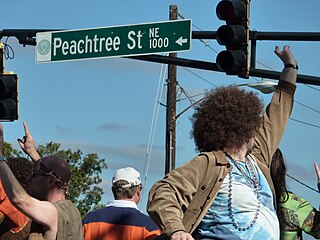
Peachtree Street is one of several major streets running through the city of Atlanta. Beginning at Five Points in downtown Atlanta, it runs North through Midtown; a few blocks after entering into Buckhead, the name changes to Peachtree Road at Deering Road. Much of the city's historic and noteworthy architecture is located along the street, and it is often used for annual parades,, as well as one-time parades celebrating events such as the 100th anniversary of Coca-Cola in 1986 and the Atlanta Braves' 1995 World Series victory.
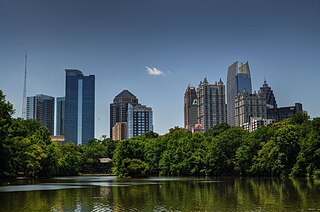
Midtown Atlanta, or Midtown, is a high-density commercial and residential neighborhood of Atlanta, Georgia. The exact geographical extent of the area is ill-defined due to differing definitions used by the city, residents, and local business groups. However, the commercial core of the area is anchored by a series of high-rise office buildings, condominiums, hotels, and high-end retail along Peachtree Street between North Avenue and 17th Street. Midtown, situated between Downtown to the south and Buckhead to the north, is the second-largest business district in Metro Atlanta. In 2011, Midtown had a resident population of 41,681 and a business population of 81,418.

Buckhead is the uptown commercial and residential district of the city of Atlanta, Georgia, comprising approximately the northernmost fifth of the city. Buckhead is the third largest business district within the Atlanta city limits, behind Downtown and Midtown, a major commercial and financial center of the Southeast.
East Atlanta is a neighborhood on the east side of Atlanta, Georgia, United States The name East Atlanta Village primarily refers to the neighborhood's commercial district.
The Atlanta BeltLine is a former railway corridor around the core of Atlanta, Georgia, under development in stages as a multi-use trail. Some portions are already complete, while others are still in a rough state but hikeable. Using existing rail track easements, the BeltLine is designed to improve transportation, add green space, and promote redevelopment. There are longer-term visions for streetcar or light-rail lines along all or part of the corridor.
Kirkwood is a national historic designated neighborhood on the east side of Atlanta, Georgia, United States. It is a historic streetcar suburb, and was designed by architect Will Saunders. Kirkwood is situated entirely in DeKalb County, bordered by the neighborhoods of Lake Claire, East Lake, Edgewood, and Oakhurst. Kirkwood is bound on the north by DeKalb Avenue, on the south by Memorial Drive and Interstate 20, on the west by Montgomery Street, and on the east by 1st Ave. A large part of the neighborhood is listed on the National Register of Historic Places as Kirkwood Historic District.

The Sweet Auburn Historic District is a historic African-American neighborhood along and surrounding Auburn Avenue, east of downtown Atlanta, Georgia, United States. The name Sweet Auburn was coined by John Wesley Dobbs, referring to the "richest Negro street in the world," one of the largest concentrations of African-American businesses in the United States. A National Historic Landmark District was designated in 1976, covering 19 acres (7.7 ha) of the neighborhood, significant for its history and development as a segregated area under the state's Jim Crow laws.
Timeline of mass transit in Atlanta:

Joel Hurt (1850–1926) was an American businessman. He was the president of Trust Company of Georgia, and a developer in Atlanta. He was one of the many founders of SunTrust Bank.
The Atlanta Street Railway was the first streetcar system in Atlanta.

The Equitable Life Assurance Building is a 32-story, 453 foot tall office building in Atlanta, Georgia. It is located at 100 Peachtree Street in the Fairlie-Poplar neighborhood in downtown Atlanta. A typical example of an International-style skyscraper, the building was designed by Chicago-based architectural firm Skidmore, Owings and Merrill, and was constructed in 1968 on the site of the former Piedmont Hotel. The building's "EQUITABLE" signage was an easily recognizable piece of the downtown Atlanta skyline, while the tower's black finish stood in sharp contrast to the surrounding buildings. The building's signage was changed in late 2018 to now host a digital signage board for the new main tenants.
The transportation system of Georgia is a cooperation of complex systems of infrastructure comprising over 1,200 miles (1,900 km) of interstates and more than 120 airports and airbases serving a regional population of 59,425 people.
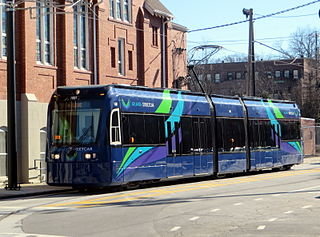
The Atlanta Streetcar or Downtown Loop is a streetcar line in Atlanta, Georgia, United States.
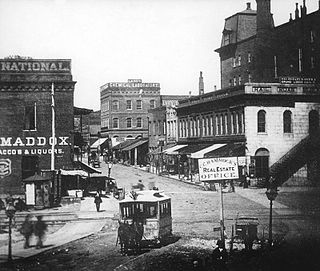
Streetcars originally operated in Atlanta downtown and into the surrounding areas from 1871 until the final line's closure in 1949.
In Atlanta, Georgia, trolleybuses, generally called trackless trolleys there, were a major component of the public transportation system in the middle decades of the 20th century, carrying some 80 percent of all transit riders during the period when the system was at its maximum size. At the end of 1949 Atlanta had a fleet of 453 trolleybuses, the largest in the United States, and it retained this distinction until 1952, when it was surpassed by Chicago.
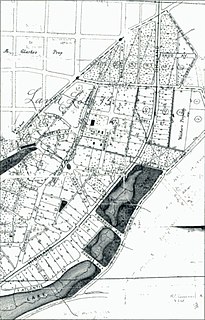
Copenhill, Copenhill Park, or Copen Hill was a neighborhood of Atlanta, Georgia which was located largely where the Carter Center now sits, and which now forms part of the Poncey-Highland neighborhood.
Laurent DeGive was the Belgian consul in Atlanta, Georgia in the late 19th century. He arrived in Atlanta in 1859. He built two opera houses in Atlanta, DeGive's Opera House, and DeGive's Grand Opera House, which would later become Loew's Grand Theatre, where Gone with the Wind (film) premiered.
Atlanta's transportation system is a complex infrastructure of several systems, including 47.6 miles of heavy rail, 91 bus transit routes, 1,600 licensed taxis, a comprehensive network of freeways, the world's busiest airport and over 45 miles of bike paths.
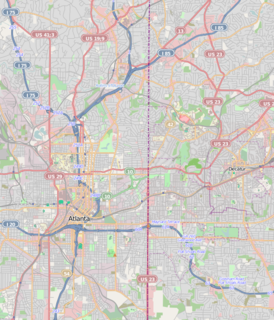
Edgewood Avenue is a street in Atlanta, Georgia, United States which runs from Five Points in Downtown Atlanta, eastward through the Old Fourth Ward. The avenue runs in the direction of the Edgewood neighborhood, and stops just short of it in Inman Park. Edgewood Avenue was first important as the route of a streetcar line to Inman Park, Atlanta's first garden suburb and home to many of its most prominent citizens. Today, the avenue is known for its restaurants and nightlife around its intersection with Boulevard.
The Atlanta streetcar strike of 1916 was a labor strike involving streetcar operators for the Georgia Railway and Power Company in Atlanta, Georgia. Precipitated by previous strike action by linemen of Georgia Railway earlier that year, the strike began on September 30 and ended January 5 of the following year. The main goals of the strike included increased pay, shorter working hours, and union recognition. The strike ended with the operators receiving a wage increase, and subsequent strike action the following year lead to union recognition.